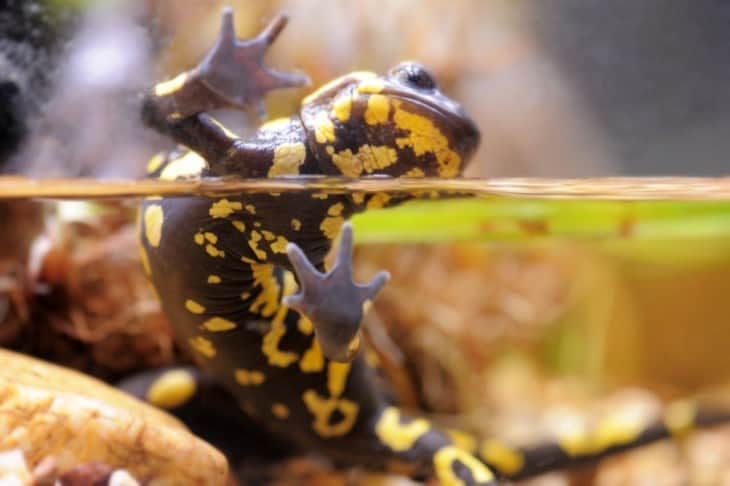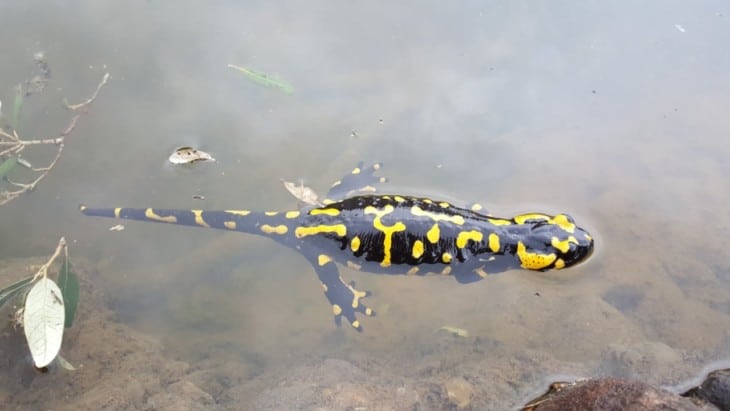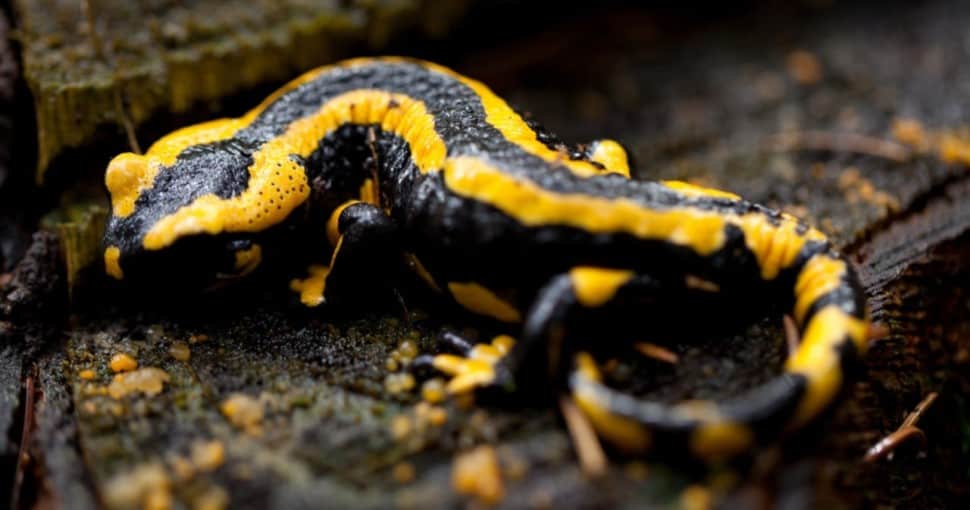Salamanders are amphibians, and they live in water and on land. They look similar to lizards, but they have moist, smooth skin. While lizards love to lay in the sun, salamanders will seek moist habitats under rocks and near rivers and streams.
Contents
While salamanders can have bright colors, their bite is not poisonous to people. However, their skin is poisonous, so you should always wash your hands and avoid touching your mouth or your eyes if you touch one. They secrete this substance from the glands in their skin, and it can cause irritation. They are harmless if you don’t touch them.
As long as you refrain from handling salamanders, they are harmless. However, you need to understand what to do if you or your pets do touch them.
Don’t confuse salamanders with skinks. Some types may look alike, but they’re different animals.
Are Salamanders Poisonous to Dogs?
Although salamanders don’t have venom in their bite, they do secrete poison from their skin glands. Their bright yellow color is meant to be a warning that this is the case. Salamanders can be poisonous to dogs, so you should not allow your dog to play with or chase a salamander.
If your dog catches a salamander and puts it in its mouth, the poison will enter the dog’s body right away. It only takes a few minutes before your dog will show signs, such as tremors, salivating, rapid breathing, respiratory distress, vomiting, or severe muscle spasms. In fact, in some cases dogs can die of asphyxiation within minutes or hours.
If your dog is poisoned by a salamander, you should immediately rinse the mouth with water and call the vet. There is no actual antidote, so you need to get your dog to the vet right away. Keep your dog away from salamanders, as they can be lethal to them.
Are Salamanders Poisonous to Cats?
Salamanders can be poisonous to cats. Cats have predatory instincts, and they perk up when they see a critter running across the floor or the ground. Salamanders can have toxicity that ranges from mild to fatal, and they excrete it through glands in their skin. If you see your cat licking or picking up a salamander, you need to take action right away.

If your cat has been poisoned, you might notice any of the following symptoms: diarrhea, vomiting, excessive thirst, pawing at tongue and mouth, loss of appetite, seizures, convulsions, coma, and even death. Different types of salamander will have different levels of poison, so you should seek vet care right away if you know that your cat has been in contact with a salamander.
Another concern is that your cats can contract liver flukes, which are parasitic worms. The larvae are in the salamander, and they can transfer to your cat. They take between eight and twelve weeks to mature, and then they will block the bile duct and trap toxins in your cat’s liver.
The best way to keep your cat safe is to do whatever you can to make sure that it doesn’t come into contact with a salamander.
Are Salamanders Poisonous to Livestock?
Some livestock will not pay any attention to salamanders. For example, although salamanders are poisonous, they are not a threat to horses or to goats. These animals will have no interest in the salamanders and rarely would consider picking them up in their mouths. Salamanders are also not a threat to deer, as they are grazing herbivores similar to horses.
Although salamanders are poisonous, they are not dangerous to chickens. Chickens have good instincts, and they are unlikely to eat something that is toxic to them. Most people who have chickens and ducks report that they do eat salamanders without any harmful effects.
Are All Salamanders Poisonous?
Although salamanders appear to be harmless, all species are poisonous. This is different from being venomous. A salamander won’t poison you when it bites you. They secrete poison from the glands on their skin. You need to hold it or ingest it to be poisoned.

Different species of salamander have different levels of poison, so some are milder than others. The Rough Skinned Newt, taricha granulosa, is the most toxic salamander and possesses tetrodotoxin, which is an incredibly potent toxin.
Salamanders are harmless to people as long as you don’t handle them. The reason that they are dangerous to dogs and cats is that both animals have predatory instincts, and they will chase and eat a salamander. Although salamanders vary in the strength of their poison, you need to be careful not to let your pet get near any of them.
Do Salamanders Bite?
Salamanders are generally shy amphibians, but they can bite if they feel threatened. If you reach your hand close enough, a salamander could mistake it for food. Some salamanders have teeth, but others don’t. They do most of their biting when they are eating. Their teeth are very small, and if one does bite you, it is unlikely to hurt very much. Their jaws aren’t powerful, and the bite feels more like a prick of a pin.
They have poison that is secreted from their glands on the skin. You can avoid coming into contact with the poison by refraining from handling the salamander. Salamanders are docile for the most part, and they are much more interested in finding food and shelter than in biting people or any other kind of animal.
The poison is designed to deter predators and, more importantly, to kill their prey. Predators eat the tail of the salamander with the poison, and then, when the predator dies from the poison, the salamander has a meal.
Salamanders are less likely to create any serious problems for people, but they can be lethal to dogs and cats. If you have these pets, you need to make sure to keep them away from salamanders. You should try to identify the type of salamander that is living on your property and check with your vet to find out how poisonous it is. Take your dog or cat to the vet right away if it eats a salamander.



